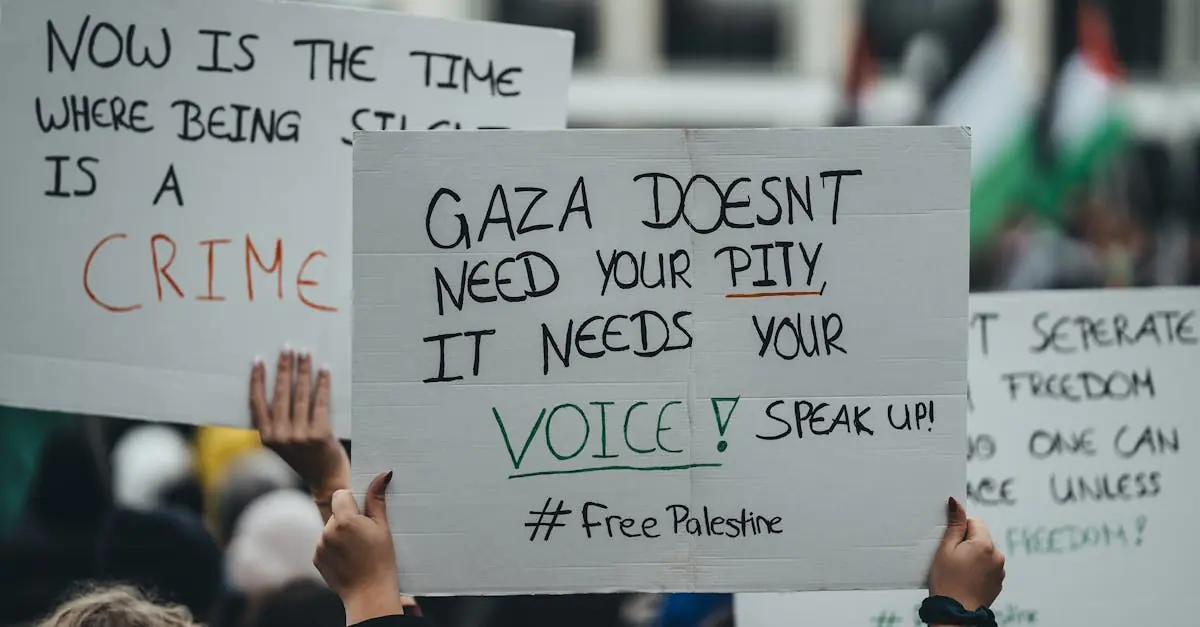Table of Contents
ToggleIn a world where political debates can feel like watching paint dry, active public participation is the secret sauce that spices things up. It’s not just a fancy term; it’s the heartbeat of democracy and community engagement. When folks roll up their sleeves and dive into political affairs or local organizations, magic happens. They transform dull meetings into vibrant discussions and turn passive observers into passionate advocates.
Understanding Active Public Participation
Active public participation involves engaging citizens in political affairs and community organizations. This engagement fosters a sense of ownership among individuals regarding political and social issues. Many organizations strive to create avenues for community involvement, enhancing the decision-making process.
Individuals participating actively contribute diverse perspectives and solutions. Those engaged in discussions often bring valuable insights that may otherwise go unheard. The involvement of community members drives transparency and accountability in governance.
Opportunities for participation include attending town hall meetings, joining advocacy groups, and contributing to online forums. Each of these spaces allows people to voice concerns and influence local policy.
Research shows that active participation leads to stronger communities. Areas with higher levels of engagement often experience improved social cohesion and trust in leadership. Engaging the public in political processes ensures that decisions reflect the population’s needs and aspirations.
Encouraging public involvement creates a dynamic political environment, one where ideas can flourish rather than stagnate. Facilitators of community organizations play a crucial role in motivating individuals to take part. They create initiatives that remove barriers to participation, making engagement accessible for everyone.
Importance of Active Public Participation
Active public participation plays a crucial role in fostering democratic values and building strong communities. It empowers citizens to engage in decision-making processes and promotes accountability among leaders.
Enhancing Democracy
Democracy thrives on the engagement of its citizens. Participation in political affairs brings diverse viewpoints into discussions, making policy-making more representative. Town hall meetings create spaces for open dialogue where people express their concerns. Forums allow the exchange of ideas, encouraging citizens to become advocates for change. Evidence shows that communities with active participation report higher levels of trust in government entities. Involvement not only democratizes decision-making but also inspires civic responsibility.
Strengthening Communities
Communities benefit immensely from active public participation. Collaborative efforts lead to stronger social bonds and enhanced neighborhood identity. Individuals joining advocacy groups often find a network of support, enabling meaningful action on local issues. Collective problem-solving empowers residents to address challenges together, fostering unity. Research indicates that neighborhoods with higher participation rates experience a decline in crime and an increase in community pride. By bringing people together, participation enriches local cultures, creating a vibrant environment for all.
Forms of Active Public Participation
Active public participation encompasses various forms such as civic engagement and community organizing. These avenues allow citizens to influence political and community landscapes effectively.
Civic Engagement
Civic engagement includes activities that promote participation in local and national governance. It involves voting in elections, attending town hall meetings, and engaging in public discussions. Citizens express opinions and advocate for issues that impact their lives. Participation in these initiatives fosters dialogue between leaders and constituents. Research shows that active civic engagement correlates with higher levels of trust in government and civic responsibility. Local organizations often encourage involvement by hosting workshops and informational sessions. Engaging youth in civic life helps instill democratic values early, creating informed future voters. Varied platforms such as social media amplify these opportunities, enabling wider involvement.
Community Organizing
Community organizing focuses on mobilizing individuals around shared concerns and objectives. It empowers groups to identify issues within their neighborhoods and advocate for tangible changes. Organizers often facilitate meetings, build coalitions, and cultivate leadership skills among participants. Grassroots movements derive strength from collective action aimed at addressing specific community needs. Evidence indicates that neighborhoods with strong organizing efforts experience enhanced social cohesion and community identity. Local activists work tirelessly to tackle challenges like public safety, education, and healthcare access. Engaging diverse voices within organizing efforts ensures representation and promotes innovative solutions. Ultimately, community organizing fosters resilience and strengthens the fabric of local society.
Challenges to Active Public Participation
Active public participation faces several challenges that hinder effective engagement in political affairs and community organizations. Understanding these barriers is crucial for fostering meaningful involvement and representation.
Barriers to Engagement
Limited access to information often prevents individuals from participating in discussions. Many community members lack awareness of meetings or events, which reduces their involvement. Additionally, time constraints affect participation rates; busy schedules hinder attendance at town halls or workshops. Language barriers also manifest, making it difficult for non-native speakers to engage with the community. Anxiety about public speaking can deter individuals from expressing their opinions, leading to underrepresentation of certain voices. Moreover, socioeconomic factors contribute to disparities in participation, with those facing financial challenges often excluded from civic activities.
Solutions for Improvement
Enhancing communication channels can significantly boost public engagement. Providing clear information about meetings and events through social media and community bulletin boards ensures accessibility. Organizations can also offer incentives for participation, such as free childcare or transportation services. Implementing workshops aimed at building public speaking skills helps individuals gain confidence in voicing their opinions. Creating multilingual resources breaks down language barriers and encourages broader participation. Additionally, fostering partnerships with local schools or businesses can increase outreach efforts and mobilize diverse groups within the community.
Case Studies of Successful Participation
Active public participation influences various levels of governance and community dynamics. Case studies illustrate effective engagement across local and national contexts.
Local Initiatives
Local initiatives often showcase community engagement at its best. Neighborhood groups frequently organize town hall meetings to discuss pressing issues. These events provide a platform for residents to voice their concerns, shaping community policies in real time. Another example involves participatory budgeting, where citizens allocate portions of municipal budgets to projects. This method empowers residents, fostering ownership and investment. Successful local initiatives often lead to improved public services and strengthened community ties. Data demonstrates that areas with engaged local initiatives report higher satisfaction levels among residents. Communities that actively encourage involvement can cultivate a collaborative spirit, reinforcing social cohesion.
National Movements
National movements illustrate the power of collective action on a larger scale. Social movements often emerge from grassroots campaigns advocating for social justice and policy reform. Recent examples include the climate justice movement, which unifies individuals across various demographics toward a common goal. Utilizing social media effectively mobilizes participants and amplifies their messages. Engaging a broad audience enables these movements to influence policy discussions at national levels. Research shows that movements like these can significantly impact legislation, leading to meaningful changes. The participation rates in national movements highlight the importance of shared goals and collective effort. When citizens come together, they can drive substantial shifts in political discourse and public policy.
Active public participation is crucial for a thriving democracy and resilient communities. It empowers citizens to voice their opinions and influence decision-making processes. By fostering dialogue and collaboration, communities can address local issues more effectively and build trust in leadership.
Engagement in political affairs not only enhances accountability but also cultivates a sense of belonging among residents. As individuals come together to advocate for change, they create a vibrant environment where diverse ideas can flourish. Overcoming barriers to participation will further strengthen community bonds and enhance civic responsibility.
Ultimately, encouraging active involvement in political and community organizations is essential for nurturing democratic values and ensuring that every voice is heard.





